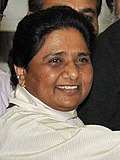Top Qs
Timeline
Chat
Perspective
Chief Minister of Uttar Pradesh
Head of the Government of Uttar Pradesh, India From Wikipedia, the free encyclopedia
Remove ads
The chief minister of Uttar Pradesh is the head of the Government of Uttar Pradesh. As per the Constitution of India, the governor is the state's de jure head, but de facto executive authority rests with the chief minister. Following elections to the Uttar Pradesh Legislative Assembly, the governor usually invites the party (or coalition) with a majority of seats to form the government. The governor appoints the chief minister, whose council of ministers are collectively responsible to the assembly. Given that he has the confidence of the assembly, the chief minister's term is for five years and is subject to no term limits.[1]
On 26 January 1950 Govind Ballabh Pant, premier of United Provinces, became the first chief minister of the newly renamed Uttar Pradesh. Including him, 11 out of UP's 21 chief ministers belonged to the Indian National Congress. Among these is V. P. Singh, a future prime minister of India, as was Charan Singh of the Bharatiya Lok Dal. On ten occasions, most recently in 2002, the state has come under President's rule, leaving the office of chief minister vacant. UP has also had two women chief ministers—Sucheta Kripalani and Mayawati. Akhilesh Yadav of the Samajwadi Party served as the chief minister of Uttar Pradesh from 2012 to 2017; having taken the oath at 38 years of age, he is the youngest person to have held the office. Only three chief ministers completed their official tenure of five years: Mayawati, Akhilesh Yadav, and Yogi Adityanath.
Yogi Adityanath of the Bharatiya Janata Party is serving as the incumbent chief minister since 19 March 2017.
Remove ads
Oath as the state chief minister
The chief minister serves five years in the office. The following is the oath of the chief minister of Uttar Pradesh:
I, <Name of Chief Minister>, do swear in the name of God/solemnly affirm that I will bear true faith and allegiance to the Constitution of India as by law established, that I will uphold the sovereignty and integrity of India, that I will faithfully and conscientiously discharge my duties as a Minister for the State of Uttar Pradesh and that I will do right to all manner of people in accordance with the Constitution and the law without fear or favour, affection or ill-will.
Remove ads
Prime ministers of United Provinces (1937–50)
The United Provinces, headquartered in Allahabad was a province of British India that comprised present day Uttar Pradesh and Uttarakhand. Under the Government of India Act 1935, a bicameral legislature was set up with a legislative assembly and a legislative council.
Remove ads
Chief ministers of Uttar Pradesh
Summarize
Perspective
Remove ads
Statistics
Summarize
Perspective
List by chief minister
Only 6 of them served longer than the total length of President's rule (4 year, 228 days).
Remove ads
Timeline
Representation of chief ministers by party
- Indian National Congress (45.23%)
- Bharatiya Janata Party (18.22%)
- Samajwadi Party (13.92%)
- Bahujan Samaj Party (9.61%)
- Janata Party (3.61%)
- Bharatiya Kranti Dal (2.07%)
- Indian National Congress (O) (0.62%)
- Janata Dal (0.42%)
- President's Rule (6.3%)

Notes
- When President's rule is in force in a state, its council of ministers stands dissolved. The office of chief minister thus lies vacant. At times, the legislative assembly also stands dissolved.[5]
References
External links
Wikiwand - on
Seamless Wikipedia browsing. On steroids.
Remove ads





















